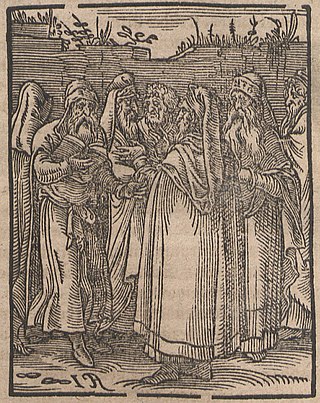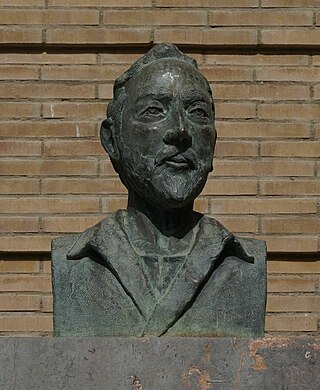Related Research Articles

Blood libel or ritual murder libel is an antisemitic canard which falsely accuses Jews of murdering Christians in order to use their blood in the performance of religious rituals. Echoing very old myths of secret cultic practices in many prehistoric societies, the claim, as it is leveled against Jews, was rarely attested to in antiquity. According to Tertullian, it originally emerged in late antiquity as an accusation made against members of the early Christian community of the Roman Empire. Once this accusation had been dismissed, it was revived a millennium later as a Christian slander against Jews in the medieval period. The first examples of medieval blood libel emerged in England in the mid 1100s before spreading into other parts of Europe, especially France and Germany. This libel, alongside those of well poisoning and host desecration, became a major theme of the persecution of Jews in Europe from that period down to modern times.

Kabbalah or Qabalah is an esoteric method, discipline and school of thought in Jewish mysticism. It forms the foundation of mystical religious interpretations within Judaism. A traditional Kabbalist is called a Mekubbal.

Moses ben Maimon (1138–1204), commonly known as Maimonides and also referred to by the Hebrew acronym Rambam, was a Sephardic rabbi and philosopher who became one of the most prolific and influential Torah scholars of the Middle Ages. In his time, he was also a preeminent astronomer and physician, serving as the personal physician of Saladin. He was born and lived in Córdoba in al-Andalus within the Almoravid Empire on Passover eve 1138 or 1135, until his family was expelled for refusing to convert to Islam. Later, he lived in Morocco and Egypt and worked as a rabbi, physician and philosopher.

Averroism refers to a school of medieval philosophy based on the application of the works of 12th-century Andalusian philosopher Averroes, a commentator on Aristotle, in 13th-century Latin Christian scholasticism.

The Cairo Geniza, alternatively spelled the Cairo Genizah, is a collection of some 400,000 Jewish manuscript fragments and Fatimid administrative documents that were kept in the genizah or storeroom of the Ben Ezra Synagogue in Fustat or Old Cairo, Egypt. These manuscripts span the entire period of Middle-Eastern, North African, and Andalusian Jewish history between the 6th and 19th centuries CE, and comprise the largest and most diverse collection of medieval manuscripts in the world.

The Seal of Solomon or Ring of Solomon is the legendary signet ring attributed to the Israelite king Solomon in medieval mystical traditions, from which it developed in parallel within Jewish mysticism, Islamic mysticism and Western occultism.
History of European Jews in the Middle Ages covers Jewish history in Europe in the period from the 5th to the 15th century. During the course of this period, the Jewish population experienced a gradual diaspora shifting from their motherland of the Levant to Europe. These Jewish individuals settled primarily in the regions of Central Europe dominated by the Holy Roman Empire and Southern Europe dominated by various Iberian kingdoms. As with Christianity, the Middle Ages were a period in which Judaism became mostly overshadowed by Islam in the Middle East, and an increasingly influential part of the socio-cultural and intellectual landscape of Europe.

The Rhineland massacres, also known as the German Crusade of 1096 or Gzerot Tatnó, were a series of mass murders of Jews perpetrated by mobs of French and German Christians of the People's Crusade in the year 1096,. These massacres are often seen as the first in a sequence of antisemitic events in Europe which culminated in the Holocaust.

Benjamin of Tudela, also known as Benjamin ben Jonah, was a medieval Jewish traveler who visited Europe, Asia, and Africa in the twelfth century. His vivid descriptions of western Asia preceded those of Marco Polo by a hundred years. With his broad education and vast knowledge of languages, Benjamin of Tudela is a major figure in medieval geography and Jewish history.

The Jewish hat, also known as the Jewish cap, Judenhut (German) or Latin pileus cornutus, was a cone-shaped pointed hat, often white or yellow, worn by Jews in Medieval Europe. Initially worn by choice, its wearing was enforced in some places in Europe after the 1215 Fourth Council of the Lateran for adult male Jews to wear while outside a ghetto to distinguish them from others. Like the Phrygian cap that it often resembles, the hat may have originated in pre-Islamic Persia, as a similar hat was worn by Babylonian Jews.

Moshe Gil was an Israeli historian.

Norman Arthur Stillman, also Noam, is an American academic, historian, and Orientalist, serving as the emeritus Schusterman-Josey Professor and emeritus Chair of Judaic History at the University of Oklahoma. He specializes in the intersection of Jewish and Islamic culture and history, and in Oriental and Sephardi Jewry, with special interest in the Jewish communities in North Africa. His major publications are The Jews of Arab Lands: a History And Source Book and Sephardi Religious Responses to Modernity. In the last few years, Stillman has been the executive editor of the "Encyclopedia of Jews in the Islamic World", a project that includes over 2000 entries in 5 volumes.
Robert G. Hoyland is a historian, specializing in the medieval history of the Middle East. He was a student of historian Patricia Crone and was a Leverhulme Fellow at Pembroke College, Oxford. He is currently Professor of Late Antique and Early Islamic Middle Eastern History at New York University's Institute for the Study of the Ancient World, having previously been Professor of Islamic history at the University of Oxford's Faculty of Oriental Studies and a professor of history at the University of St. Andrews and UCLA.
Josef (Yousef) Waleed Meri is an American historian of Interfaith Relations in the Middle East and the history of religion.
Sahl ibn Bishr al-Israili, also known as Rabban al-Tabari and Haya al-Yahudi, was a Jewish or Syriac Christian astrologer, astronomer and mathematician from Tabaristan. He was the father of Ali ibn Sahl the famous scientist and physician, who became a convert to Islam.
The 1066 Granada massacre took place on 30 December 1066 when a Muslim mob stormed the royal palace in Granada, in the Taifa of Granada, killed and crucified the Jewish vizier Joseph ibn Naghrela, and massacred much of the Jewish population of the city.
Mark R. Cohen is an American scholar of Jewish history in the Muslim world.
Bernard Stanley Bachrach was an American historian. He taught history at the University of Minnesota from 1967 until his retirement in 2020. He specialized in the Early Middle Ages, mainly on the topics of medieval warfare, medieval Jewry, and early Angevin history. He also wrote an important article about the treatment of Jews in the Visigothic kingdom.

Jewish copper plates of Cochin, also known as Cochin plates of Bhaskara Ravi-varman, is a royal charter issued by the Chera Perumal king of Kerala, south India to Joseph Rabban, a Jewish merchant magnate of Kodungallur. The charter shows the status and importance of the Jewish colony in Kodungallur (Cranganore) near Cochin on the Malabar Coast.

The persecution of Jews during the Black Death consisted of a series of violent mass attacks and massacres. Jewish communities were often blamed for outbreaks of the Black Death in Europe. From 1348-1351, acts of violence were committed in Toulon, Barcelona, Erfurt, Basel, Frankfurt, Strasbourg and elsewhere. The persecutions led to a large migration of Jews to Jagiellonian Poland and the Grand Duchy of Lithuania. There are very few Jewish sources on Jewish massacres during the Plague.
References
- ↑ Ray, Jonathan (2014-02-19). "Thereconquistaand the Jews: 1212 from the perspective of Jewish history". Journal of Medieval History. 40 (2): 159–175. doi:10.1080/03044181.2014.888521. ISSN 0304-4181.